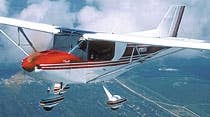
||| |---|---| | | | The FAA proposed the broadest changes to existing pilot and light plane certification standards in decades, when it published its proposal for the new Light-Sport Pilot and Light-Sport Aircraft rules. The Notice of Proposed Rulemaking (NPRM) was published in late January. The public has 90 days to comment on it (on or before May 6th). If the rule is enacted, and that process could take months or years, the FAA estimates that it would lead to the licensing of 10,000 new pilots and the creation of many new airplanes over the next decade.
New Aircraft The proposal would create a new class of simple, light, certified aircraft, to be called "light-sport aircraft." These single-engine, fixed-gear airplanes would weigh a maximum of 1,232 pounds, carry no more than two occupants, have a single non-turbine engine, stall no faster than 39 knots and have a maximum airspeed of 115 knots. Some existing simple aircraft, like Piper Cubs, Aeronca Champs and the like, might qualify, but the largest number of aircraft grandfathered in as certified would be illegal sport aircraft, the so-called "fat" ultralights, ultralight style craft that are flown without certification while exceeding the FAA's definition (FAR Part 103) of an ultralight.
Three kinds of existing airplanes could be grandfathered in to the light-sport certificate: (fat) ultralights that don't meet the requirements of Part 103; aircraft assembled from kits that don't meet the 51-percent rule; and airplanes issued an exemption to the light-sport rules.
The new rule is the holy grail of the homebuilt airplane manufacturing industry, which for years has pressed the FAA to allow it to build and sell simple, almost ready-to-fly airplanes. When governed by the FAA's 51 percent amateur builder rules, the process for constructing such simple airplanes is complex and time-consuming. Kit makers believe that their business would skyrocket if they could sell their airplanes certified and ready to fly.
The rule would allow aircraft to be built and delivered to the customer without the FAA directly overseeing the process. These new-construction airplanes would meet airworthiness standards developed not by the FAA but by the industry and would be certified as light-sport aircraft. Only this class of light-sport aircraft could be used for instruction and rental purposes.
Two new categories of aircraft and class ratings would be added, as well, for weight shift aircraft (powered hang glider-type craft) and for powered parachutes, a potentially large market for makers of recreational aircraft.

Sign-up for newsletters & special offers!
Get the latest FLYING stories & special offers delivered directly to your inbox






